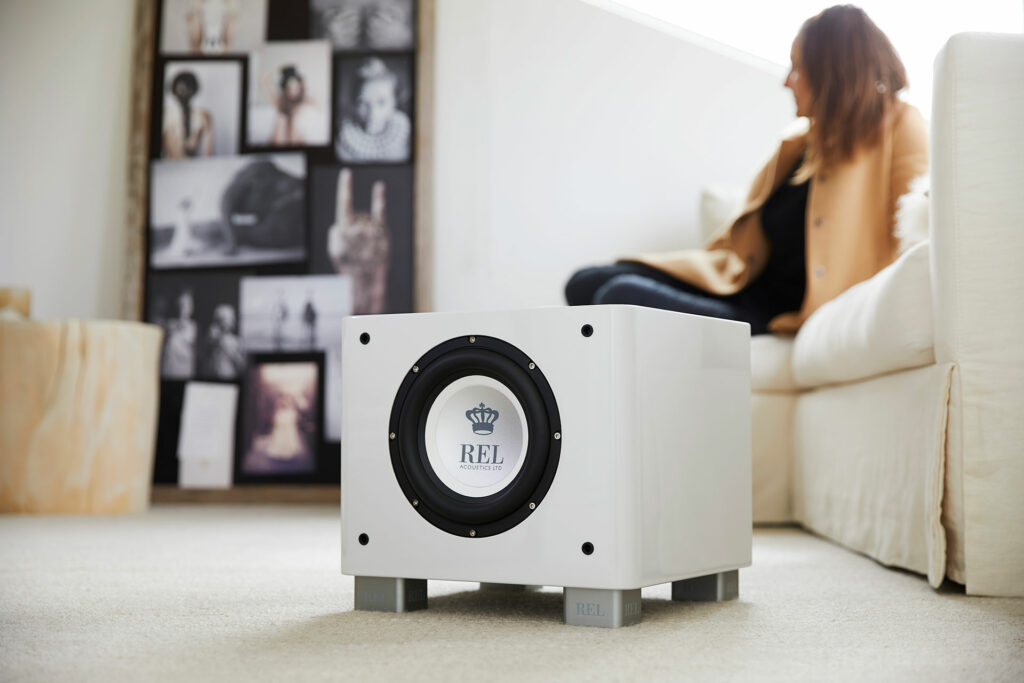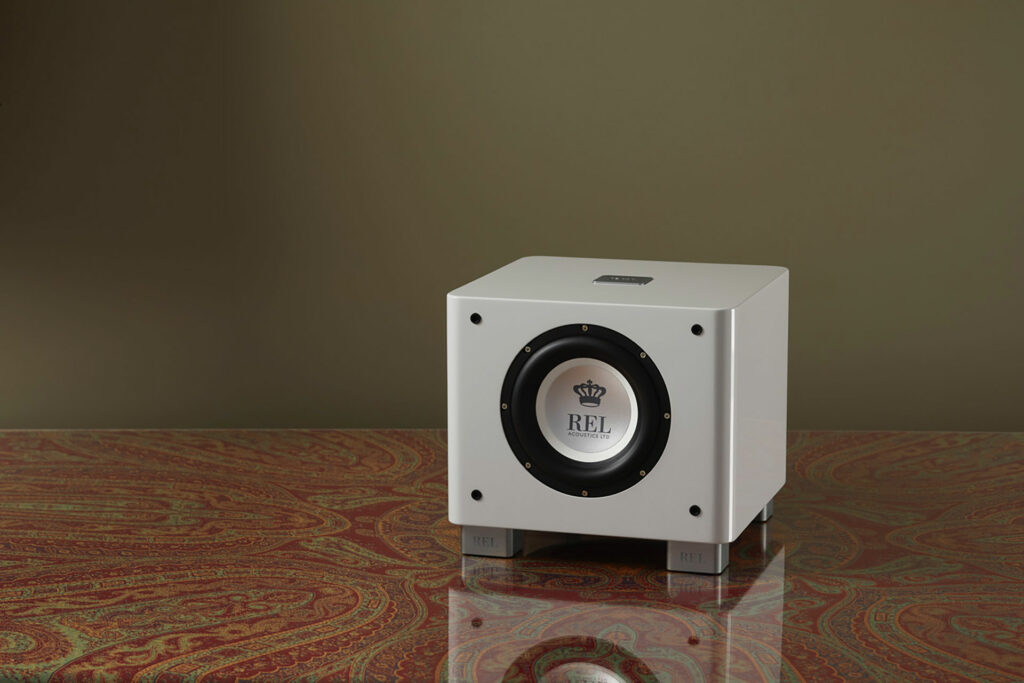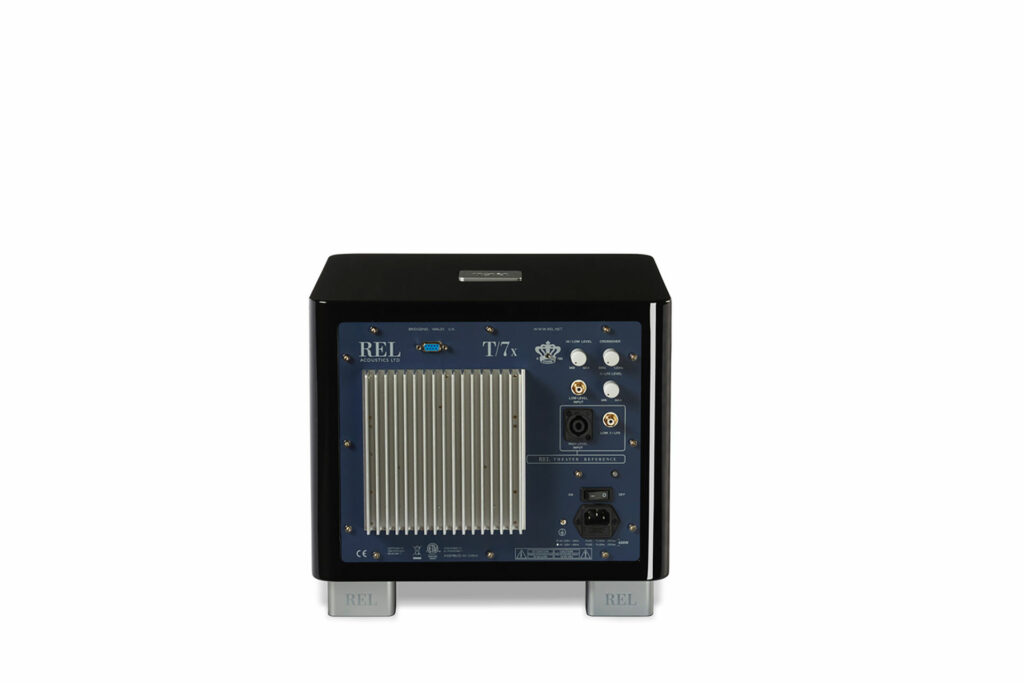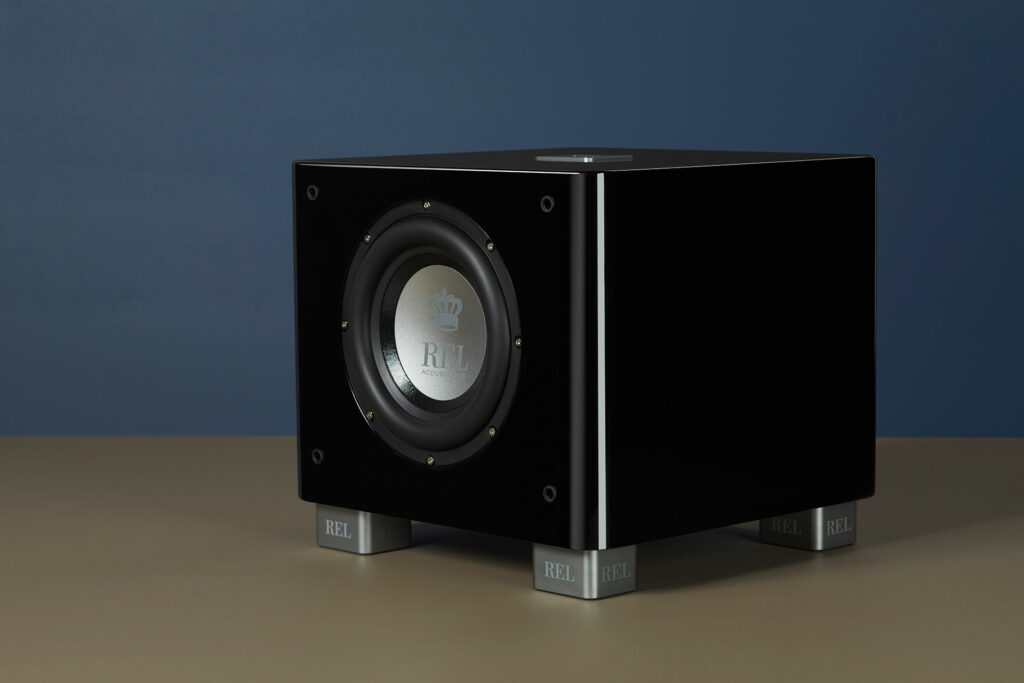REL Acoustics is a well-known subwoofer manufacturer with fourteen different models across five lines. Unlike many hi-fi companies, REL only makes subs, with a focus on how a sophisticated subwoofer design can extend the capabilities of even the most exotic speaker designs. Of course, subwoofers are essential for home theater, but as I will discuss later in the review. REL subwoofers are specifically engineered and voiced for audiophile music playback. The company’s approach includes choosing the right subwoofer, considering your primary right and left speakers, and the application. I recently reviewed the Magnepan LRS+ main speakers, and part of that review required adding a pair of subwoofers. I worked with REL to choose the correct match for the LRS+, and while there were a few models that would work, I ended up with the REL T/7x (a pair, in fact), which will be the topic of this review.
The REL T/7x retails for $1,099 and falls into the middle of the company’s Serie T/x line . It is proclaimed by the manufacturer as possibly their best-measuring balanced model in the T/x range. The T/7x’s compact size, stiff and light active and passive drivers, and high-current class AB amplifier with advanced connectivity options combine to create a compelling combination of features that work synergistically for superb integration to the audio system’s main speakers.

What Makes the REL T/7x Subwoofer So Special?
- REL’s proprietary cable and Neutrik Speakon connector for the high-level subwoofer input with fast filters allow connection to the amplifier’s high-level speaker outputs without any power loss. Connection in this manner is a significant departure from the typical RCA line-level interconnect cable we are all familiar with. With the high-level Neutrik Speakon connectivity, the subwoofer receives the exact audio signal with the same character as the main right and left speakers, an essential aspect of the REL design that sets it apart from other subwoofer manufacturers.
- A low-level LFE (Low-Frequency Effects) input is provided and should be used with the high-level Neutrik Speakon subwoofer input. This functionality is critical when the audio system’s function is for music and home theater.
- An eight-inch FibreAlloy active cone woofer and 10-inch downward-firing passive radiator made of the same material, which is super light yet ridged, are attached to a firm suspension with 200 millimeters and 250 millimeters of excursion, respectively.
- REL uses a high-current 200-watt Mosfet class AB amplifier with large power reserves designed for high performance.
- At 14 inches wide, 12.5 inches high, and over 14 inches deep, the T/7x is compact for a high-performance subwoofer. Its vertical radius corners give its cabinet the illusion of appearing even smaller.
- A high-quality painted finish, available in piano black lacquer or high gloss white lacquer, applied in five coats, is consistent with the finest musical instruments or most gorgeous audio equipment I have seen to date.
- REL offers Arrow Wireless, an optional proprietary wireless connection system with zero compression. The company indicates the wireless transmission of the digital audio signal is indistinguishable from a wired subwoofer connection in direct comparison and that the setup is straightforward and intuitive.
- The solid and thick aluminum REL nameplate on top of the subwoofer is part of the cabinet design to help tune the enclosure. In contrast, the solid billet aluminum feet are weighty and keep the subwoofer planted on the floor.

Why Should You Care About the REL T/7x Subwoofer?
The REL T/7x blends all the right stuff with a music-first approach as well as great support for the .1 channel of movie soundtracks. REL explains that the bass in the main right and left speakers is significant and should not be redirected to the subwoofer by cutting low frequencies through a crossover in your preamp. Again, this is a substantial departure from what is customary in this hobby.
Additionally, the T/7x is big enough to make enough deep bass that not only extends the capabilities of your main speakers but does so while retaining the low-level details of the audio track with panache, but small enough to fit in a room aesthetically – even if there are a pair of them. To accomplish this feat, carefully manufactured and curated drivers and amplifiers, combined with proprietary technology and the proper specifications, culminate in a knockout product. It is not about any of these criteria individually, but rather the sum of the parts, design, and implementation that collectively yields a high-performing result that will thrill you.

Some Things You Might Not Like About the REL T/7x Subwoofer…
- At first, I can see why one may be disappointed about the absence of digital signal processing (DSP) on the REL T/7x; however, it is an intentional part of the REL design. REL does not believe DSP is the best way to work with bass signals. The company prefers to build the subwoofer and the drivers in a manner that does not require DSP and is more focused on matching the main speakers to the correct subwoofer model, positioning the main left and right speaker for the best imaging and transparency, and then locating each subwoofer for best bass response, balance, and blend with the proprietary high-level Neutrik Speakon connection, along with phase, crossover, and gain adjustments.
- If the subwoofers are part of an AV system with some kind of room correction then the processor. This is where DSP is best applied according to REL but overall they are more into physical placement and professional/manual setup. They don’t like to double down in the DSP department.
- A mobile app that can control volume, crossover point, and phase is now a common feature of subwoofers. The REL T/7x has no such mobile app. While I would have preferred the app control functionality feature, it is not a dealbreaker by any means. The reality is once the system is set up, it does not require continual adjustment: users tend to set it and forget it.
- While the REL T/7x plays deep and works extraordinarily for music, for the most demanding movie soundtracks in notably large rooms, the compact sub has limitations, as suggested by its self-proclaimed low-frequency extension down to only 30 Hz. Remember, this is a small subwoofer; while it can and does push out those lower frequencies, the subterranean frequencies often found on action movie soundtracks will be best served moving up the REL product line into the S series at a higher price. However, as you will see below, in my smaller home theater room, the T/7x worked well.
Listening to the REL T/7x Subwoofer…
For the primary evaluation, a pair of Pass Labs XA60.8 monoblock amplifiers and an accompanying Pass Labs XP-12 preamplifier provided power and control of the speakers. A Bluesound Node was the streaming source. I used two different speaker models in combination with the REL 7/Tx: the Magnepan LRS+ and the new Bowers and Wilkins 805 D4 stand-mount, reference monitor loudspeakers. All equipment used WireWorld Electra power cables and Eclipse 8 interconnect and speaker cables.
I listened to various tracks, starting with the Magnepan LRS+ speakers without the T/7x powered on. After multiple location, height, and angle adjustments, the LRS+ performed well with acoustical soft rock or jazz genres; however, bass-heavy tracks underwhelmed without the addition of a sub. “Use Somebody” by Kings of Leon is one such track. The T/7x rounded out the presentation without setting itself apart from the main speakers, showcasing accurate texture and detail of the lower bass precisely, extending the lower end of the frequency range. I could feel the increase in bass pressure within the room while the bass guitar and percussion instruments could be differentiated, clearly revealing various timbres. I don’t recall experiencing these characteristics with any subwoofer I have had in my listening room. It is an actual magic trick in my book when you consider the fast LRS+ Magneplanar diaphragm and how the REL T/7x was just as fast, allowing it to blend in seamlessly while extending the bass beyond the capabilities of the LRS+.
With the Bowers & Wilkins 805 D4, REL’s head designer, John Hunter, visited my home, where he spent about an hour and a half re-positioning the 805s, improving imaging and transparency. John then spent 15 minutes positioning the T/7xs while adjusting phase, crossover frequency, and gain for each subwoofer. Once everything was dialed in, the presentation was first-rate. For example, in the song “Cranberry” by Charlie Houston, the entire image blossomed when the T/7x pair was engaged. I chose this song out of many not because it is a significant bass test but rather a pleasant track with an underlying bass line that was subtle but significant enough to recruit the T/7x gently. The result was a robust improvement to bass extension while uplifting the entire image. I also noticed the T/7x did not possess a typical subwoofer sound I have learned to accept: the type of sound where it is obvious a subwoofer is wagging at the bottom end of the range. Instead, the T/7x turned the 805s into a high-performing full-range speaker without drawing attention to itself, with a much larger overall image, especially in height.
To determine how the REL T/7x impacts a movie soundtrack, I streamed the movie Deep Water Horizon on an Apple TV 4K through an NAD M17 processor. The Pass Labs XP-12 was kept in the loop through the Home Theater Bypass input so that I could use the components mentioned above, including the Bowers and Wilkins 805 D4’s, with the REL T/7x engaged, and without any room correction applied on the processor. However, the processor did have speaker distances input into the speaker layout, and the front left, center, and right speakers were set to large as suggested by REL.
Deep Water Horizon has extended scenes of demonic bass throughout the massive destruction of the oil rig. With the T/7x pair receiving bass signal from the right and left speaker outputs and low level .1 LFE movie soundtrack; it was a compelling experience to hear so much detail in the lower registers. With pipes bursting, bolts busting, and propulsion engines grinding, there was no shortage of auditory information to keep one focused on the action. The subwoofers handled it exquisitely, pumping out detail and clarity with enough room pressure that I could feel it. Did it shake my smallish room and seating like a larger subwoofer would? Somewhat. While room pressure could be felt, it was not quite the same as a larger subwoofer would play, nor would I expect it to be. But if that is what you are looking for, REL has a solution for you. It just isn’t this one.
Will the REL T/7x Subwoofer Hold Its Value?
I suspect the REL T/7x will have average to above-average resale value due to the company’s high consumer reputation, and this particular model is a sweet spot product that should translate to limited supply on the secondary market. Short supply will drive higher resale value. The small size of the sub makes the box easier to save for many AV enthusiasts and shipping not as prohibitively expensive or back-breakingly difficult.

What Is the Competition for the REL T/7x Subwoofer?
The SVS SB-3000 ($1,099 – buy at Crutchfield) is a sealed box subwoofer without ports or a passive radiator. I use a pair of these subwoofers daily since they are on active duty in my Dolby Atmos system in the living room. It is a physically larger subwoofer than the REL, as it houses a 13-inch driver. SVS uses a class D amplifier specified at 800 watts RMS, with a peak rating of 2500 watts. The frequency response is 18 Hz to 270 Hz. When comparing to the 7/Tx, both subwoofers do a fantastic job. Still, the REL does a better job of naturally blending with the main speakers while offering detail, timbre, and contour of bass drums and other lower-frequency instruments. The SVS subs have similar sonic qualities and impressive output but perhaps not the same unique finesse as the T/7. The SVS has more room-shaking capability, which is understandably appealing in a high-performance subwoofer.
Since we are on the topic of SVS, the company also offers the SVS PB-2000 Pro ($1,099 – buy at Crutchfield) which is front-ported, with dimensions much larger than the T/7x. It only comes in a black ash finish priced at $1,099. With a high-efficiency Class D amplifier rated at 550 watts RMS and 1500 peak output, with a frequency response of 19 to 240hz, combined with the SVS mobile app control, the PB-2000 Pro offers incredible bang and boom for the buck. Ported subs move much more air, giving you that “making my pant legs flap in the breeze” effect. Many audiophiles traditionally tend to prefer a sealed box design for music but that’s about as relevant as serving a fine white Burgundy with a steak. The rules are different today and that is a good thing.
JL Audio is a well-known subwoofer manufacturer, and within its Dominium line is the d108, priced at $1,200, with a similar gloss black finish to the REL. The d108 uses an eight-inch active driver, which is in line with the 7/Tx, but in a sealed box design. JL Audio implements proprietary technology in the d108, such as DMA (Dynamic Motor Analysis) and VRC (Vented Reinforcement Collar). Power comes from a Class D 500-watt power amplifier and system frequency response is specified as 31 Hz to 112 Hz. The d108 offers wireless connectivity through the JLINKTM TRX system, sold separately. However, JL Audio lacks the speaker-level audio input.
Final Thoughts on The REL Serie T/7x…
The T/7x made me realize what a subwoofer could mean to a complete audiophile system. I never thought a subwoofer could integrate cohesively with such detailed and accurate bass, creating a virtual extension of the main speakers as it did for the Magnepan LRS+ and the much more expensive Bowers & Wilkins 805 D4s. As I mentioned in my listening evaluations, I have never had a subwoofer in my home that so seamlessly integrated into my system. Another way to think of the T/7x: if you have speakers you cherish but now take for granted, desiring a step up in performance, consider adding a REL T/7x or two to your system. They can and will supercharge the speakers you already know and love with sonic ease and finesse but without breaking the bank.



